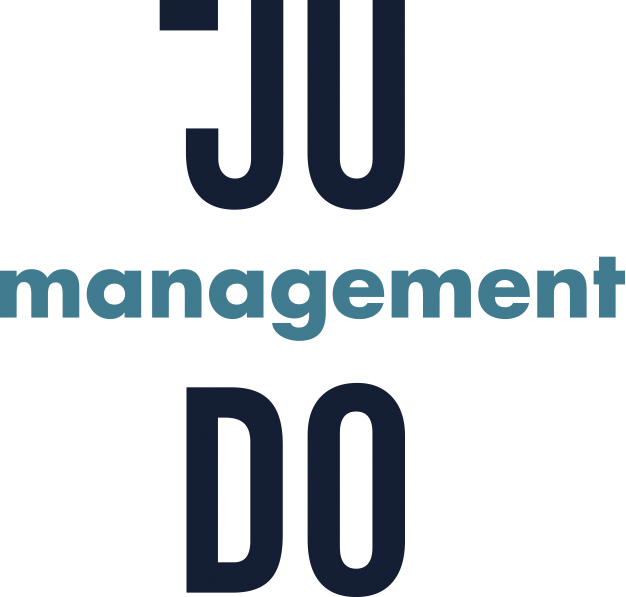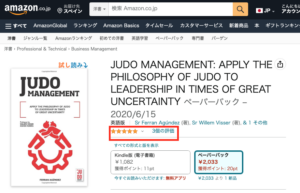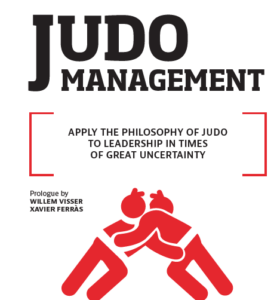In 1977 a book by Anton Geesink was published with the title “Safety through Perfection”. On the front page is Anton Geesink who, in a blue judogi, performs a migi uchi mata, which is blocked by Leo de Vries, in a yellow judogi, in a way that many judoka of today do not know and also tai sabaki is clearly visible!. Fortunately, only blue remained of the experiment with colored judogi, because there was already enough “noise and colorful fair” in the development of Judo.
In this article I use the title of the book, not because a book review will follow, but because “Safety through Perfection” is an excellent one-liner from Anton Geesink, which is still very effective at this time, in 2020.
Incidentally, there are more one-liners from Anton Geesink, such as: “You may have your own opinion, but this must be the same as mine, Anton Geesink”; an opinion is often in the middle of the line between ignorance and knowledge…
Another, always very good to use, one-liner and unfortunately also out of use:
“If you want to be a champion, you have to look like a champion” a saying by Anton Geesink that even hangs as an inspiration image in Kokushikan University; the Kokushikan who trained the Olympic Champions Saitoh, Uchishiba and Suzuki, among others. Incidentally, there is a tree in sight of the dojo, which was planned there by Anton Geesink and which has now literally grown into a great symbol…)
“Safety through perfection” rightly implies that imperfection can lead to insecurity. Insecurity can therefore be the cause of an injury. Perfection is a guarantee of safety!
In a previous article I wrote about “Hazumi & Ikioi”, about “essence & tools”. The essence in judo is technique and the tools are forms of strength and endurance. Without repeating the previous article too much, it is necessary to state here again that the tools must never overshadow the essence, because Judo then becomes unrecognizable and especially because Judo was not developed for that. Whether one speaks of Judo as a pedagogical game, as a sport, as an Olympic sport or as a movement-cultural activity, Judo must always be permeated with the specific, unique and great values that are so characteristic of Judo.
In Judo, perfection means that technology and movement must be developed optimally, conditioned to Judo. This applies not only to the technique of attack, but also the technique of defense.
In the international competition rules, for example, kani basami and waki gatame from a standing position are prohibited for safety reasons.
(Incidentally, it is up to the referee’s knowledge and responsibility to judge waki gatame from a standing position and gross mistakes are made, including internationally. In naming the essence of Judo I distinguish between technique and movement; inseparable, but distinguishable. Both deserve attention to be described in more detail. In my book “Kodokan Go Kyo no Waza” I describe throwing techniques, I indicate a fundamental preparatory movement for each throw and the biomechanics are explained by means of a drawing. (In addition to those basic preparatory movements, other preparatory movements are possible!)
The total training of a judoka therefore also includes the specific posture and movement formation for Judo, such as shizen tai, jigo tai, kumi kata, tai sabaki, shintai, kuzushi, tsukuri.
Complete control of shizen tai, jigo tai, kumi kata, tai sabaki, shintai, kuzushi, tsukuri and the perfect performance of nage waza and ne waza give stability to the judoka. Paying too much attention to kumi kata and not paying attention to shizen tai, jigo tai, tai sabaki, and shintai, and paying little attention to nage waza and ne waza is a major flaw in judo education and judo training!
(In the book «le judo, evolution de la compétition» by Patrick Vial, Daniel Roche and Claude Fradet, kumi kata is described on pages 15 to 53. ISBN 2-7114-0748-9)
In a total training, the judoka is developed in such a way that he/she is able to act “conditioned” in and respond to any situation. There must be an automatic balance and not the slightest imperfection possible; respond quickly and adequately to constantly changing situations, often limited by time and space; remain in control of the situation.
Perfect technical execution alone is not enough; posture and movement must also be perfect, both in offensive and defensive aspects.
For a perfect judo technique, for a perfect judo attitude and for a perfect judo movement, the teacher / coach is responsible for that development; especially the teacher who taught, trained and guided the basic education.
This means that the teachers who “do” the basic training, must be very skilled teachers. Judo is an unprecedentedly complicated form of movement and the intelligence of the teacher also plays a major role in this, because the basis of biomechanics, dynamics and logic must be “projected” on the individual, the individual who is always different.
(In the training of teachers mainly engaging in “sitting football”, “leapfrog” and “children’s kata” does not lead to the expertise required to perfectly train judoka.)
If a judoka gets injured, the teacher or coach should feel responsible for the basic formation; technique, posture, movement. Even if a judoka loses a match, the teacher or coach must feel responsible, even in the case of mental shortcomings of the judoka!
A judoka who loses or gets injured because of an omission in the basic formation may deem the teacher who led the basic formation responsible for this. Just as good as that one may consider the strength trainer or endurance trainer, which incorrectly periodizes, to be responsible.
If a judoka is seriously injured towards the end of the Olympic qualification period, for example due to incorrect movement (unconditioned judo movement), it is not he or she, but the teacher and / or the coach who is responsible.
And the above leads to the conclusion that those responsible for training programs should not bring more strength, but more intelligence into the training programs.
The higher the level of judo practice, the more specific, in-depth and individual the guidance must be.
Willem Visser, Executive coach, Strategic Adviser, International Lecturer 8th Dan Judo IJF
With gratitude to all my teachers, specialists, colleagues and especially all the judoka that I was allowed to guide and to coach.
Sources and inspiring professionals:
Van der Horst, Cobben, Abe, Saitoh, Yamashita, Uemura, Sugawara, Murata, Hosokawa, Komata, Takahashi, Nakamura, Kasuga, Kawashima, Kariya, Brousse, Besson, Rougé, Ruska, Geesink, de Cree, Barta, Vachun, Viser, Lascau, McConnell, Snijders, Sins, Hoogendijk, Boersma, Odinot, van Dijk, Klok and many others.




